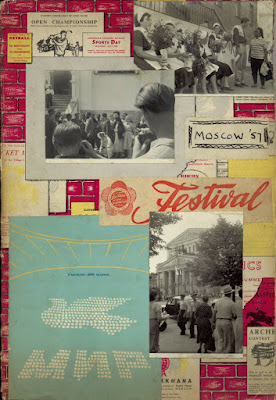
About John Ford is a very interesting mixture of critical analysis of the films of John Ford, mixed with Anderson's personal reminiscences of his meetings with John Ford, and interviews he conducted with various people who worked with Ford. Anderson's admiration of John Ford began in 1946 when he first saw My Darling Clementine. It continued through his reviews and articles about Ford in Sequence, his meetings with Ford over the years, and two television programmes: an Omnibus two-part programme on Ford narrated by Anderson (1992) ; and a Channel Four programme (1987) , where Anderson gave a 'masterclass' to a group of students about the art of film-making through the example of My Darling Clementine
The boxes relating to About John Ford contain: notes made by Anderson on Ford's films; press cuttings re: John Ford; early drafts of the book; correspondence with friends, colleague's and family of Ford; correspondence with publishers; correspondence with readers and critics; promotional material for the book; and reviews of the book.
The first big piece of detective work was with the early drafts of the book. There were some pages paper clipped together which obviously ran as a section (anything from 2 pages to 32 pages long), but there were no page numbers or chapter headings to work out where in the published version of the book they relate to. The first decision I had to make was, do I take the time to locate each of these draft sections in the published book? Well, I quickly decided that yes, it was worth the time to do this as it would be of value to future researchers, and it's always interesting to see what remains and what is changed from draft to published version. So then, how to work out where all these pages were located in the published book? Not that I'm claiming any great shakes as a detective, just common sense really, but I determined that the quickest way would be to use the index in About John Ford, and look for the least common, or least famous, actors names or place names. Where there were only a few occurrences of a name it was relatively quick to locate the draft pages and reference them in my cataloguing. Now, this may not be interesting to everyone, but somehow to me, this job was immensely satisfying - I guess that's why I'm an archivist!
Another problem I encountered was due to my less than all encompassing knowledge of John Ford's films. By this I must confess that prior to cataloguing this material I had only seen one Ford film, The Quiet Man. So I started attending screenings for John Izod's class 'Genre in Hollywood: The Western' (the benefits of working in a University!) . I have now seen, and enjoyed, My Darling Clementine, Stagecoach, and Iron Horse. Only a drop in the ocean as far as the number of John Ford films but it has helped with the cataloguing. It didn't help me much though when I came across a file with four black&white photographs of stills from John Ford films. With so many films to choose from, and having seen so few of them, I was having real trouble trying to identify them. So, rather than spend huge amounts of time going through images on IMDb from all his films, I decided to call in the cavalry (excuse the bad pun!). I e-mailed Charles Barr, a Professor of Film at University College Dublin and a John Ford expert (Charles Barr gave a very interesting paper About the John Ford Archive at our conference in September). Charles was able to identify the images for me, including the photograph of Charley Grapewin, from 'Tobacco Road' (1941) which I've included here.

LA/4/3/10/3, Still from Tobacco Road
© Lindsay Anderson Collection, University of Stirling Archives
N.B. John Ford's papers are held at the Lilly Library, Indiana University in Bloomington, Indiana.







